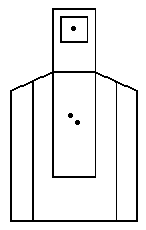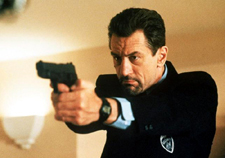The Mozambique Drill Reexamined
The Mozambique Drill or Failure Drill in Tactical Shooting
 The
Mozambique Drill or “Failure to Stop Drill” or simply “Failure
drill” drill is perhaps the most popular and stylized shooting
technique in self-defense and tactical training today.
The
Mozambique Drill or “Failure to Stop Drill” or simply “Failure
drill” drill is perhaps the most popular and stylized shooting
technique in self-defense and tactical training today.
It is a simple yet effective method that has been used in the special ops community and made it’s way into popular media and Hollywood. It is simply characterized as a double tap (two quick shots in succession) to center mass, followed up by one to the head.
ORIGINS
Rhodesian Mike Rousseau was serving as a mercenary in the Mozambican War of Independence (1964-74). While engaged in fighting at the airport of Lourenco Marques (modern-day Maputo), Rousseau was armed with only a Browning HP35 pistol. As he turned a corner, he bumped into a FRELIMO guerrilla armed with an AK-47. Rousseau immediately performed a "double tap" maneuver, a controlled shooting technique in which the shooter makes two quick shots at the target's torso. Rousseau hit the target on either side of the sternum, usually enough to incapacitate or kill a target outright. Seeing that the guerrilla was still advancing, Rosseau made an attempt at a head shot that hit the guerrilla through the base of his neck, severing the spinal cord.
Rousseau later related the story to an acquaintance, Jeff Cooper (1920-2006), one of the 20th century's foremost international experts on the use and history of small arms. Cooper later incorporated the "triple tap" maneuver (two quick shots to the torso and one quick-aimed shot to the head) into his practical shooting technique. Rousseau was later killed in action in the Rhodesian War.
 Jeff
Cooper, recognized as the father of what is commonly known as "the
Modern Technique" of handgun shooting, described the Mozambique
Drill as such in his Commentaries:
Jeff
Cooper, recognized as the father of what is commonly known as "the
Modern Technique" of handgun shooting, described the Mozambique
Drill as such in his Commentaries:
I added The Mozambique Drill to the modern doctrine after hearing of an experience of a student of mine up in Mozambique when that country was abandoned. My friend was involved in the fighting that took place around the airport of Lourenço Marques. At one point, Mike turned a corner and was confronted by a terrorist carrying an AK47. The man was walking toward him at from perhaps 10 paces. Mike, who was a good shot, came up with his P-35 and planted two satisfactory hits, one on each side of the wishbone. He expected his adversary to drop, but nothing happened, and the man continued to close the range. At this point, our boy quite sensibly opted to go for the head and tried to do so, but he was a little bit upset by this time and mashed slightly on the trigger, catching the terrorist precisely between the collar bones and severing his spinal cord. This stopped the fight.
The effect of a bullet striking the human body depends greatly on which organ is struck during penetration. In some instances, the assailant might drop quickly; in others, there might be no apparent effect. A bullet striking the brain kills the assailant almost without exception. Recognizing that similar situations would occur, Cooper popularized the term Mozambique Drill based on the technique improvised by his student there. This drill consists of shooting two rounds to the center of the torso, followed by a pause and assessment of the situation and then a more carefully aimed shot to the head. Under nearly any condition, engaging an assailant with the Mozambique Drill should offer a high probability that one's assailant will be stopped and likely killed.
POPULAR CULTURE
The Mozambique drill has also infiltrated pop culture in film and TV, likely for its slick and “tacticool” visual translation.
 Michael
Mann (Heat, Manhunter, Miami Vice, Collateral) has used the
technique prominently in his films which often involve cops, skilled
criminals, and hit men. Tom Cruise’s “Vincent”,
a hit man, repeatedly uses the technique in “Collateral”.
Robert DeNiro’s character uses it to execute Wayne Groe
in “Heat”.
Michael
Mann (Heat, Manhunter, Miami Vice, Collateral) has used the
technique prominently in his films which often involve cops, skilled
criminals, and hit men. Tom Cruise’s “Vincent”,
a hit man, repeatedly uses the technique in “Collateral”.
Robert DeNiro’s character uses it to execute Wayne Groe
in “Heat”.
In Showtime’s TV show, Dexter season 2, Sergeant Dokes (who has a special ops background) alludes to a crime scene victim being “Mozambiqued” or “triple tapped” as he explained it. The drill is also alluded to in Ridley Scott’s “Blackhawk Down”.
When US Navy Seal Team Six killed Osama Bin Laden in his compound in Abbottabad, Pakistan on May 1, 2011 many news reports and experts also mentioned that the targets in the compound were likely killed by a double tap to center mass, following a shot to the head, which these analysts and experts referred to as standard practice in the special ops community.The technique has also gained notoriety in the tactical training community, as the popularity of the “tacticool” and “mall ninja” crowd embrace anything associated with spec ops/military/hollywood cool.
Tom Cruise uses the Mozambique Drill technique on the second adversary in the "briefcase" scene of Collateral. Cruise underwent extensive firearms training for the role.
PRACTICAL OPERATION
The Mozambique drill is a very simple technique, one that is logical in it’s intent and effectiveness. The name of the otherwise known “Failure to Stop” drill clearly indicates it’s origin (described above). It is a quick combination technique to surely and swiftly neutralize a target from advancing.
Shooting for center mass is a defensive technique used for it’s
effectiveness, as most operators, especially in high stress situations,
have a greater probability of hitting the target if aiming for center
mass. Even the most skilled operator will not make every head shot,
and in a life and death situation you simply can’t gamble with
those odds. However, the reality of many situations is that torso shots
will not stop an adversary. This has been seen time again in both battle,
and in self-defense situations.
Body armor and bullet proof vests can protect an adversary (this concept widely popularized by Hollywood), and in some cases an attacker under the influence of drugs can sustain non-lethal torso wounds and continue to rapidly advance.
In the “Blackhawk Down” scenario experienced by our armed forces in Somalia, they also encountered the issue of smaller rounds designed to “pierce“, but not having true “knockdown power” have little stopping effectiveness in torso shots. They were hitting their Somali targets, but not “dropping” them and the wounded Somalis were still standing and firing back (this was largely in part that they were using armor piercing 5.56 cartridges, that were not fragmentable, thus the rounds were penetrating without much soft tissue damage. However, the importance of a head shot in the situation stands).
The only sure shot is a head shot, but that is a lower percentage shot.
So the Mozambique logically combines both of best worlds, so to speak,
in a quick trainable technique.
ZOMBIE TACTICAL SCENARIO
Well, we are zombie tactical after all. The Mozambique drill is a failure to stop drill. In the case of zombie lore, we know that a headshot (or brain damage, decapitation) is necessary to kill the threat. You can still slow down the threat with a body shot or by undercutting the legs.
One must also stress the importance of conservation of ammo in a SHTF (shit hits the fan) situation.
Therefore the Mozambique Drill does not have the same level of effectiveness in a zombie tactical application. In theory (where ammo conservation is not an issue) the initial double tap would be effective at slowing down the target and “setting up” a head shot. A single center of mass shot followed by an attempted head shot would likely serve better. Ultimately it is the head shot that counts in a zombie kill scenario, so anything that would aid accomplishing that goal, while conserving ammo would be ideal.

